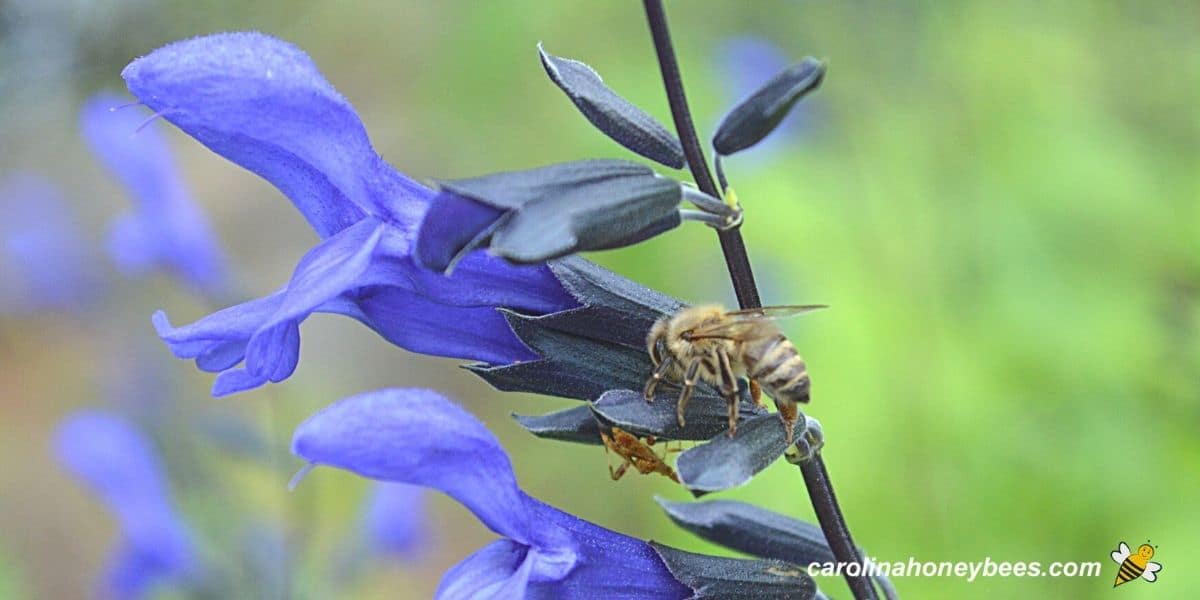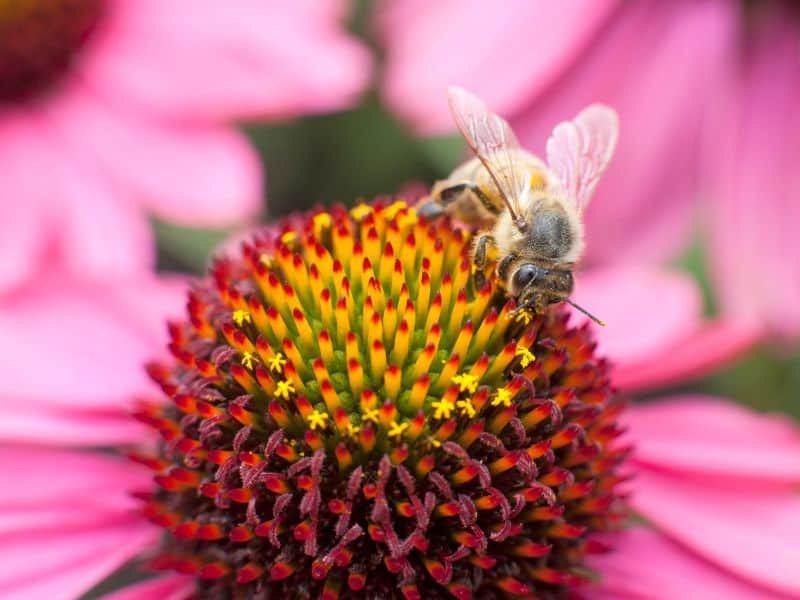Flowers For Honey Bees
Many gardening enthusiasts love to include useful flowers for honey bees in their gardens. This is a great way to help honey bees and other pollinators. However, not every flower is useful to bees – we want those that provide nectar, pollen or both. Deciding which flowers are best for bees depends on several factors – including your growing conditions. But, every location is suitable for some type of bee friendly flower.

As a gardener and beekeeper for years, I have a wide selection of blooming flowers in my honey bee gardens. You don’t have to have a large space – perhaps you can make several small areas for bees to visit.
Top Flowers for Honey Bees
My motto is “if I have to dig a hole to plant something – it better feed my bees!” Even small gardens can play a role in providing a diverse diet for beneficial insects.
Here are some of the most popular flowers for honey bees:
- anise hyssop
- aster
- bee balm
- blanketflower
- blazing star
- blue vervain
- fireweed
- purple coneflower
- salvia

Anise Hyssop (Agastache spp.)
Anise Hyssop is one of the most bee-attractive native flowers in North America. Happiest is full sun to part shade, the purple or white flowers appear in Summer. There are several species to choose from and some have a sugar concentration of up to 40%.
Aster (Symphyotrichum spp)
You will find many varieties of aster to fit into a wide range of growing conditions. They grow well in wetland conditions to meadow settings.
Aster becomes an important fall nectar source for honey bee colonies. White, pink or blue blooms appear in late Summer into Fall. Sugar concentrations in nectar range from 24-40% or more.

Bee Balm (Monarda spp.)
With the word “bee” in the name you know this flower must be attractive to bees. Monarda does not disappoint as a bee magnet. This excellent pollinator plant attracts many different kinds of insects.
Among the numerous varieties – Spotted Beebalm is a major honey plant in some regions. Happiest in part shade, red, purple, white or pink flowers appear mid-Summer.
Blanketflower (Gaillardia spp.)
Know for it’s brilliant bright colors, blanketflower is attractive to honey bees and many native bees too. Several varieties are available.
They grow well in full sun and become covered with blooms during the Summer. Nectar concentrations hoover around 32% in good conditions.

Blazing Star (Liatris spp.)
This plant can become a major focus in the garden. Easy to grow they do well in poor soil – even during times of little rain.
Liatris grow from tuberous corm and enjoy full sun. The lavender blooms attract honey bees , butterflies, moths and humming birds.
Blue Vervain (Verbena hastata)
Blue Vervain is a wetland-adaptable plant that is easy to grow and establish. It is tolerant of wet conditions unlike many other bee flowers. Blue blooms appear in Summer. Also serves as a host plant for caterpillars.

Fireweed (Chamerion angustifolium)
Fireweed loves cool climates and high altitudes. It is considered one of the best honey plants in North America. Bees produce a light buttery flavor honey from fireweed. In fact, the flavor reminds me of Sourwood honey.
Growing well in sun to part shade, pink flowers appear in Summer. The average sugar concentration is around 35%.
Purple Coneflower (Echinacea spp.)
Purple Coneflowers must be included in any discussion about flowers attractive to bees. These plants are so easy to grow – even a new gardener can be successful. In addition to nectar, honey bees are often seen gathering pollen on cone flowers.
The common purple flowered versions are the most prolific producers. Doing well in full Sun, purple flowers appear in Summer. Once established they grow well without much maintenance.

Salvia (Salvia spp.)
The salvia family offers a lot of diversity being available both as annuals and perennials. Flower colors include white, red, pink, purple and blue. Blue flower varieties are most attractive to honey bees.
Salvia grows well in sunny locations with average to dry soil. They bloom in mid-Summer and some varieties have nectar concentrations of 40% or more.
Characteristics of Favorite Bee Flowers
Worker foraging bees will visit any nectar or pollen rich flowers. But yes, bees do have preferences.
If you want to create an ideal honey bee habitat, include plants with some of the following characteristics:
- blue, yellow or purple flowers
- simple single flower types – open petals
- perennials that return year after year

Flower Colors
Honey bees have 5 eyes that help them navigate the world and find food. However, bees see flowers differently than humans do.
They can see UV light but red looks black to the bee. They find flowers that are blue, purple and yellow most appealing.
Simple Flower Shapes
Some of the best flowers for honey bees have single flowers – avoid new hybrids with double flowers and massive blooms.
The plant with a simple flower invests more energy in nectar production and less in petal formation.
Include Perennials
Be sure to plant some perennials flowers for your bees. Returning the next year from root systems or tubers in the ground, they can live for years.
They pack a lot of “umph” for the bee garden because you only have to plant them once. Also, they provide a nice background for showy annuals that you might like.
There are several perennial herbs attractive to bees and you can enjoy the benefit of fresh herbs for the table. Thyme, easy to grow borage and echinacea all are visited by honey bees.

Extend the Season
Honey bees make honey from gathered plant nectar. Stored honey allows honey bees to survive Winter – when no food is available.
Do you know what else honey bees eat? Pollen. Bees use pollen as a protein source necessary for rearing young.
When choosing flowers for honey bees, include a mix of plants that produce nectar or pollen. Aim for a variety of flowers to create long bloom cycles. When one plant fades, another is coming into bloom all during the warm months.
Your garden can become a great food source for pollinators looking for nectar late in the season. Include some fall flowers that bees like in your garden.

Something should be in bloom all season long. If your region has a lot of blooming trees that feed bees in the Spring, (like Red Maple Trees or Tulip Poplar) add more flowers that bloom later in the season. The bees can only work so many flowers at one time.
The same applies for other native or planted flowering shrubs that attract bees? Don’t try to compete with existing forage – compliment it by adding more variety.
If you are a beekeeper, check with your local bee association to learn the times of the year when providing extra forage is most beneficial.
Depending on your climate, consider the possibility of including a few cold season plants. Bumble bees and some honey bees will take advantage of Winter flowers – if the temperature allows.
Drought Tolerant Flowers
If you have a problem area that gets very dry during parts of the year, the flowers blooming there may not produce any nectar or pollen.
These spots are great candidates for drought tolerant plants. Some types of plants – native or commercial – do better in dry conditions. They are able to not just survive but thrive when rain is scarce.

This post may contain affiliate links. As an Amazon Associate, I earn from qualifying purchases. Please read my disclosure.
Expert Tips for Planting Flowers for Bees
If you choose to grow from seed, consider a meadow mix. This provides a variety of different kinds of flowers – consider your climate as you choose.
Be wary of invasive plants the feed bees – even if they do provide nectar or pollen. In the long term, they are not a good choice for the ecosystem.
Use any chemicals or weed killers with care. Remember – bees like weeds too. But, you may want to control some growth.
Look for products that are considered bee safe weed killer option or make your own homemade weed killer – and use with care.
Not every blooming plant is a friend to pollinators. A few plants plants produce nectar or pollen toxic to bees – do your research.

Special Bee Flower Projects
Providing flowers for honey bees is easy to do. And, all of the pollinators in your area will benefit from them. Here are a few more ideas:
- looking for an annual plant with a lot of pizazz? Sunflowers – some varieties of sunflowers are good for bees. But do your homework – some are pollen-less.
- if you have an area of your yard that tends to be wet – you may create a mini rain garden to provide food for area pollinators.
- a patio or deck – small spaces –make a container garden for bees. Herbs, coneflowers, bee balm and lavender do well in containers.
- Want a unique experience? Try growing luffa flowers – sponges – bees will visit the big yellow blooms.
- involve the kids – make seed bombs with air dry clay.
FAQs
Honey bees do not eat flowers or plant tissue. They do collect sweet nectar and protein rich pollen from millions of blooming plants.
Almost everyone can provide some areas of honey bee habitat! You don’t have to live in an area with wide-open spaces to plant bee friendly flowers.
Some of the most popular varieties of honey come from blackberries or citrus plants. These are consider premium products and bring a higher price.
One of the most attractive flowers for bees is called “bee balm”. This perennial is native to North America.
No, some flowers do not require insect pollination. They may not secret nectar to attract bees.
Flowers with nectar and pollen attract bees. Those with simple flower shapes in the colors: blue, purple and yellow are most attractive to bees.
Final Thoughts
With thousands of great flowers for honey bees out there, the most difficult part is choosing which to plant. Your choice will depend on your growing conditions and available space. Each year after I include a small planting of buckwheat for my bees. It is not really pretty but it goes in the vegetable garden after the corn is finished. The bees love it.


